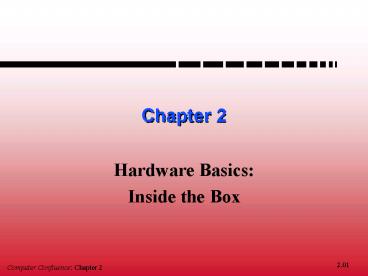Hardware Basics: - PowerPoint PPT Presentation
1 / 18
Title:
Hardware Basics:
Description:
describe the basic structure of a computer. discuss the functions and interactions of principal computer components ... K: (kilobyte); about 1,000 bytes of information ... – PowerPoint PPT presentation
Number of Views:91
Avg rating:3.0/5.0
Title: Hardware Basics:
1
Chapter 2
- Hardware Basics
- Inside the Box
2.01
2
After reading this chapter, you should be able
to
- describe the basic structure of a computer
- discuss the functions and interactions of
principal computer components - explain why a computer typically has different
types of memory and storage devices and give
examples of each
2.02
3
How It Works boxes
- How It Works boxes in your textbook provide more
technical detail than the main text has to offer. - How It Works boxes use text and graphics to
further explore the inner workings of the
computer.
2.03
4
Chapter Outline
- What Computers Do
- A Bit About Bits
- The Computers Core CPU and Memory
2.04
5
What Computers Do
- Computers are used to carry out complex
functions. - Despite their appearent complexity, computers can
only really do four things - Receive input.
- Process information.
- Produce output.
- Store information.
2.05
6
Receive Input
- Computers accept information from the outside
world. - The keyboard is the most common input device.
- Pointing devices like the mouse also receive
input.
2.06
7
Process Information
- The central processing unit (CPU) performs all
arithmetic calculations and logical decisions. - The CPU is like the brain of the computer.
2.07
8
Produce Output
- Computers produce information and send it to the
outside world. - A video monitor is a common output device.
- Printers also produce output.
2.08
9
Store Information
- Information in a computers memory can be moved
and stored at a new location. - Primary storage is the computers memory.
- Secondary storage is data on disks.
2.09
10
A Bit About Bits
- The computer uses a binary (two-digit) system.
- Binary digits, or bits, can represent numbers,
codes, or instructions. - The two digits, 0 and 1, represent the two states
of a switchoff and on.
2.10
11
Bits as Numbers
- The decimal sysem uses ten digits to represent
numbers. - 0, 1, 2 , 3 , 4 , 5 , 6 , 7 , 8 , and 9
- People use this system.
- The binary system uses two digits to represent
the numbers 0 and 1. - Computers also use the binary system.
2.11
12
Bits as Codes
- Characters can be represented as bit codes.
- A 01000001
- 5 00110101
- Color, sound, and graphics can also be converted
into bit code.
2.12
13
Bits as Instructions
- Programs can also be stored as collections of
bits. - For instance, 01101010 might instruct the
computer to add two numbers. - Other bit instructions might include where to
find numbers stored in memory or where to store
them.
2.13
14
Bit-related Terminology
- These terms might describe file size or memory
size - Bit smallest unit of information
- Byte a grouping of eight bits of information
- K (kilobyte) about 1,000 bytes of information
- MB (megabyte) about 1 million bytes of
information - GB (gigabyte) about 1 billion bytes of
information
2.14
15
The Computers Core The CPU and Memory
- The CPU is located on the motherboard.
- Functions
- Interpret and carry out program instructions.
- Do arithmetic calculations.
- Perform logical data manipulations.
- Communicate with other parts of the computer
system.
2.15
16
Factors Influencing the CPU
- Compatibility
- Not all software is compatible with any given
CPU. - New microprocessors can usually run older
software. - New software is not usually compatible with old
microprocessors. - Speed
- Speed is determined by the internal clock of a
computer and is measured in megahertz. - The architecture of a computer determines its
speed.
2.16
17
Primary Storage The Computers Memory
- RAM (random access memory)
- is the most common memory chip.
- will not remain if power goes off.
- must move data onto a disk if it is to be saved.
- ROM (read-only memory)
- information is stored permanently on a chip.
- contains startup information and other permanent
data.
2.17
18
Buses, Ports, and Peripherals
- Peripherals
- are external devices for receiving input or
producing output (keyboard, monitor, and mouse). - communicate with other parts of the system.
- provide attachment and communication with
external devices by means of - slots (for internal attachment)
- ports (for external attachments)
2.18































